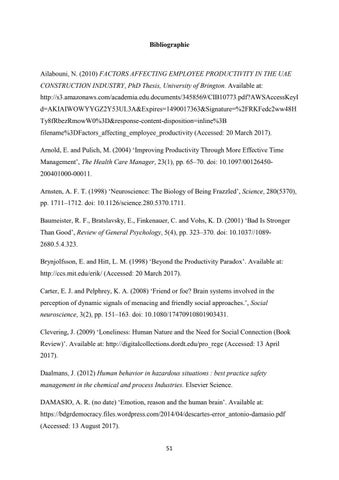Bibliographie
Ailabouni, N. (2010) FACTORS AFFECTING EMPLOYEE PRODUCTIVITY IN THE UAE CONSTRUCTION INDUSTRY, PhD Thesis, University of Brington. Available at: http://s3.amazonaws.com/academia.edu.documents/3458569/CIB10773.pdf?AWSAccessKeyI d=AKIAIWOWYYGZ2Y53UL3A&Expires=1490017363&Signature=%2FRKFedc2ww48H Ty8fRbezRmowW0%3D&response-content-disposition=inline%3B filename%3DFactors_affecting_employee_productivity (Accessed: 20 March 2017). Arnold, E. and Pulich, M. (2004) ‘Improving Productivity Through More Effective Time Management’, The Health Care Manager, 23(1), pp. 65–70. doi: 10.1097/00126450200401000-00011. Arnsten, A. F. T. (1998) ‘Neuroscience: The Biology of Being Frazzled’, Science, 280(5370), pp. 1711–1712. doi: 10.1126/science.280.5370.1711. Baumeister, R. F., Bratslavsky, E., Finkenauer, C. and Vohs, K. D. (2001) ‘Bad Is Stronger Than Good’, Review of General Psychology, 5(4), pp. 323–370. doi: 10.1037//10892680.5.4.323. Brynjolfsson, E. and Hitt, L. M. (1998) ‘Beyond the Productivity Paradox’. Available at: http://ccs.mit.edu/erik/ (Accessed: 20 March 2017). Carter, E. J. and Pelphrey, K. A. (2008) ‘Friend or foe? Brain systems involved in the perception of dynamic signals of menacing and friendly social approaches.’, Social neuroscience, 3(2), pp. 151–163. doi: 10.1080/17470910801903431. Clevering, J. (2009) ‘Loneliness: Human Nature and the Need for Social Connection (Book Review)’. Available at: http://digitalcollections.dordt.edu/pro_rege (Accessed: 13 April 2017). Daalmans, J. (2012) Human behavior in hazardous situations : best practice safety management in the chemical and process Industries. Elsevier Science. DAMASIO, A. R. (no date) ‘Emotion, reason and the human brain’. Available at: https://bdgrdemocracy.files.wordpress.com/2014/04/descartes-error_antonio-damasio.pdf (Accessed: 13 August 2017). 51


